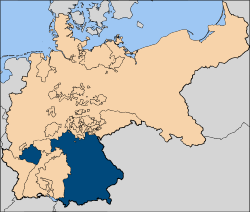
Back Reino de Bavera AN مملكة بافاريا Arabic Reinu de Baviera AST Bavariya krallığı Azerbaijani باواریا شاهلیغی AZB Kinereich Bayern BAR Каралеўства Баварыя Byelorussian Кралство Бавария Bulgarian Rouantelezh Bavaria Breton Regne de Baviera Catalan
Kingdom of Bavaria (1806–1825) Königreich Baiern Kinereich Baiern (1825–1918) Königreich Bayern Kinereich Bayern | |||||||||||||||
|---|---|---|---|---|---|---|---|---|---|---|---|---|---|---|---|
| 1806–1918 | |||||||||||||||
| Motto: In Treue fest ("Steadfast in loyalty")[1] | |||||||||||||||
| Anthem: Bayerische Königshymne (German)[2] "Bavarian Royal Hymn" | |||||||||||||||
 The Kingdom of Bavaria in 1914, as part of the German Empire | |||||||||||||||
| Status |
| ||||||||||||||
| Capital and largest city | Munich | ||||||||||||||
| Common languages | Bavarian, Upper German dialects | ||||||||||||||
| Religion | Majority: Roman Catholicism Minorities: | ||||||||||||||
| Government | Constitutional monarchy | ||||||||||||||
| King | |||||||||||||||
• 1806–1825 | Maximilian I Joseph | ||||||||||||||
• 1825–1848 | Ludwig I | ||||||||||||||
• 1848–1864 | Maximilian II | ||||||||||||||
• 1864–1886 | Ludwig II | ||||||||||||||
• 1886–1913 | Otto | ||||||||||||||
• 1913–1918 | Ludwig III | ||||||||||||||
| Prince Regent | |||||||||||||||
• 1886–1912 | Luitpold | ||||||||||||||
• 1912–1913 | Ludwig | ||||||||||||||
| Minister-President | |||||||||||||||
• 1806–1817 | Maximilian von Montgelas | ||||||||||||||
• 1912–1917 | Georg von Hertling | ||||||||||||||
• 1917–1918 | Otto Ritter von Dandl | ||||||||||||||
| Legislature | Landtag | ||||||||||||||
• Upper Chamber | House of Councillors | ||||||||||||||
• Lower Chamber | House of Representatives | ||||||||||||||
| Historical era | Napoleonic Wars Franco-Prussian War World War I | ||||||||||||||
• Proclamation of the kingdom | 1 January 1806 | ||||||||||||||
• Established | 26 December 1806 | ||||||||||||||
| 8 October 1813 | |||||||||||||||
| 30 May 1814 | |||||||||||||||
| 18 January 1871 | |||||||||||||||
| 9 November 1918 | |||||||||||||||
| 12 November 1918 | |||||||||||||||
| Area | |||||||||||||||
| 1910[3] | 75,865 km2 (29,292 sq mi) | ||||||||||||||
| Population | |||||||||||||||
• 1910[3] | 6,524,372 | ||||||||||||||
| Currency |
| ||||||||||||||
| |||||||||||||||
| Today part of | Germany | ||||||||||||||
The Kingdom of Bavaria (German: Königreich Bayern; Bavarian: Kinereich Bayern; spelled Baiern until 1825) was a German state that succeeded the former Electorate of Bavaria in 1806 and continued to exist until 1918. With the unification of Germany into the German Empire in 1871, the kingdom became a federated state of the new empire and was second in size, power, and wealth only to the leading state, the Kingdom of Prussia.[4]
The polity's foundation dates back to the ascension of Elector Maximilian IV Joseph of the House of Wittelsbach as King of Bavaria in 1806. The crown continued to be held by the Wittelsbachs until the kingdom came to an end in 1918. Most of the border of modern Germany's Free State of Bavaria were established after 1814 with the Treaty of Paris, in which the Kingdom of Bavaria ceded Tyrol and Vorarlberg to the Austrian Empire while receiving Aschaffenburg and Würzburg.
In 1918, Bavaria became a republic after the German Revolution, and the kingdom was thus succeeded by the current Free State of Bavaria.
- ^ Joost Augusteijn, Storm. H. J., Region and State in Nineteenth-Century Europe: Nation-Building, Regional Identities and Separatism, Palgrave Macmillan, 2012, p. 102.
- ^ Otto Boehm (1901), Die Volkshymnen aller Staaten des deutschen Reiches. Beiträge zu einer Geschichte über ihre Entstehung und Verbreitung, Wismar, p. 38, retrieved 15 July 2022
{{citation}}: CS1 maint: location missing publisher (link) - ^ a b Cite error: The named reference
Statisticswas invoked but never defined (see the help page). - ^ "Bavaria Becomes a Kingdom". www.museum.bayern. Retrieved 26 November 2023.

